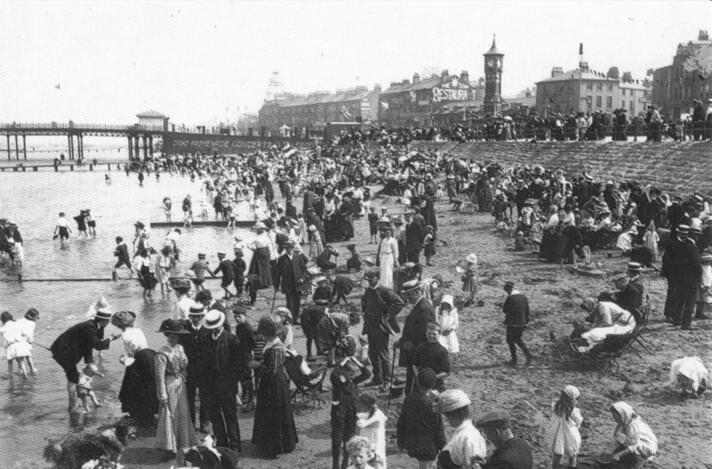
Figure 1.--Here we see Morecambe beach, we think about 1910. You can see how close the beach was to the city center. Notice Central Pier in the background. It was damaged in 1933. The West End Pier is dimly vissible in the distance. |

|
Morecambe is a resort town located right within the Lancaster city. It dates back to Roman times.
Morecambe entered the kodern era in the mid-19th century. The Morecambe Harbour and Railway Company was formed (1846). They built a port on Morecambe Bay, close to the fishing village of Poulton-le-Sands along with a connecting railway. The railway linked to Skipton, Keighley and Bradford in the West Riding of Yorkshire. A port town began to grow around the harbour and railway to both service the port and to develop a seaside resort. The beach faces Morecambe Bay, a part of the Irish Sea. This protected location means that the waves are more gentle than many Brirish beaches. Morecomb provided a wonderful local venue for ciy residents attempting to escape the summer heat. It is easily accessible by bus frm anywhere in the city. Nearby Blackpool is much better known and the predomanat venue for holiday-makers from the Lancashire mill towns. Many visitors to Morecambe came from the north, Yorkshire and Scotland. We see Scottish postcards with depivtions of Morecambe. The Children's Pond, Sandylands Promenade, is named after the area before Morecombe was officially adopted. The Children's pond was popular with children, especially the boys to test out their sail boats. The beach began to decline in the 1930s and became rather seedy. And this continued as British holidays via air travel began to turn to warm Spasnish climes. In recent years there has been a major civil improvement, a kind of facelift. There is now glistening golden sands replacing the pebble beaches and a 5-mile stretch of level promenade with innovative bird sculptures and public artworks. The Stone Jetty is now a prominant local attraction. The beach has the Lakeland Hills as a backdrop.
Morecambe dates back to Roman times.
Morecambe entered the kodern era in the mid-19th century. The Morecambe Harbour and Railway Company was formed (1846). They built a port on Morecambe Bay, close to the fishing village of Poulton-le-Sands along with a connecting railway. The railway linked to Skipton, Keighley and Bradford in the West Riding of Yorkshire. A port town began to grow around the harbor and railway to both service the port and to develop a seaside resort. Morecambe developed as primarily a seaside resort with a large proportion of the local economy based on tourism, hospitality and catering located along the seafront.
Morecambe is a resort town located right within the Lancaster city. The beach faces Morecambe Bay, a part of the Irish Sea. This protected location means that the waves are more gentle than many Brirish beaches. It is also situated at the foot of the Lake District National Park.
Morecomb provided a wonderful local venue for ciy residents attempting to escape the summer heat. It is easily accessible by bus frm anywhere in the city. Nearby Blackpool is much better known and the predomanat venue for holiday-makers from the Lancashire mill towns. Many visitors to Morecambe came from the north, Yorkshire and Scotland. We see Scottish postcards with depivtions of Morecambe. The beach began to decline in the 1930s and especially after mid-cemntury and became rather seedy.
There were a serious of incidents that adversely affected Morecombe tourism and the city's economy in general. Two piers were had to be closed and removed. Deveral attractions and facilities closed. And this continued as British holidays via air travel began to turn to warm Spanish climes.
The principal attraction at Morecombe is the beach located at the town center. The Children's Pond is also ppular. It is located at the Sandylands Promenade, named after the area before the name Morecombe was officially adopted. The Children's pond was popular with children, especially the boys to test out their sail boats. As with most British seaside resorts, there were piers with attractions and treats. There were also a variety attractions built away from the beach which proved of varying popularity.
Two piers were destroyed. The West End Pier was partly washed away in a a major storm (November 1977). The remnants had to be demolished (1978). Central Pier had been damaged by fire (1933) and was finally removed (1992). The World of Crinkley Bottom attraction in Happy Mount Park attracted little interest closed only 13 weeks after opening (1994). Then there was the Blobbygate scandal, an issue only the British can understand. Blobby is beyond the understabding of us mere colonials. The closures of Bubbles, Morecambe's swimming pool, and the Frontierland fairground was the nadir of Moresombe as a resort location. In recent years there has been a major civil improvement, a kind of facelift. There is now glistening golden sands replacing the pebble beaches and a 5-mile stretch of level promenade with innovative bird sculptures and public artworks. The Stone Jetty is now a prominant local attraction. The beach has the Lakeland Hills as a backdrop.
Navigate the Boys' Historical Clothing Web Site:
[Return to the Main English seaside resorts page]
[Introduction]
[Activities]
[Biographies]
[Catalogs]
[Chronology]
[Clothing styles]
[Countries]
[Girls]
[Literary]
[Bibliographies]
[Contributions]
[FAQs]
[Glossaries]
[Images]
[Links]
[Registration]
[Tools]
[Boys' Clothing Home]
Navigate the Boys' Historical Clothing Web Site:
[Sailor suits]
[Sailor hats]
[Buster Brown suits]
[Eton suits]
[Rompers]
[Tunics]
[Smocks]
[Pinafores]
